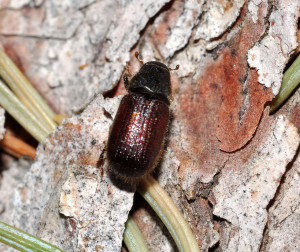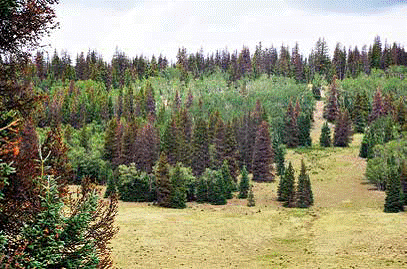Bill Ciesla
Colorado State University Extension Master Gardener in Larimer County
April 21, 2012
Almost everyone living in Colorado is aware of the massive outbreaks of mountain pine beetle underway in the state. These outbreaks have killed a high proportion of the mature pines in our lodgepole and limber pine forests statewide and now threaten ponderosa pine forests along portions of the Front Range. Relatively few people, however, are aware of another beetle that is devastating our high elevation Engelmann spruce forests: the spruce beetle. 
The spruce beetle, known in scientific circles as Dendroctonus rufipennis, is a close relative of mountain pine beetle. The two beetles are almost identical in size and overall appearance. Spruce beetle breeds under the bark of spruce and is known to cause severe damage to Engelmann spruce forests throughout the Rocky Mountains and to white spruce forests in Alaska. During the late 1800s and early 1900s, outbreaks of this same bark beetle occurred in forests of red and white spruce in the New England states and adjoining portions of eastern Canada. Another spruce infesting bark beetle, the blue spruce ips, attacks and kills Colorado blue spruce both in urban areas and natural forests; usually during excessively dry years.

Figure 2. Engelmann spruce trees infested with spruce beetles on Spring Creek Pass. Photo: William M. Ciesla
Unlike mountain pine beetle, which tends to confine its attacks to standing trees, spruce beetle outbreaks often develop in wind-thrown spruce forests. High wind episodes, such as the one that occurred in the Mt. Zirkel Wilderness (north of Steamboat Springs) in October of 1997, blew down 13,000 acres of mature spruce forests, often set the stage for spruce beetle outbreaks. Beetles invade the wind-thrown spruce and the large numbers of beetles that develop in these trees emerge two seasons later to attack surrounding standing trees. In Colorado, Engelmann spruce is usually found at elevations of 10,000 feet or above and grows either in mixture with sub-alpine fir or in pure forests just below timberline.
In Larimer County, a major outbreak of spruce beetle is currently underway in portions of the Rawah and Never Summer Mountains. The outbreak was first discovered in 2005 during aerial forest health surveys in the northern Rawah Range near the Wyoming border. This outbreak has gradually moved south into Cameron Pass, Long Draw Reservoir, the Comanche Peaks Wilderness and Milner Pass in Rocky Mountain National Park. Much of the mature spruce trees in these areas are now dead or dying. Other areas in the state include the San Juan Range, the upper Rio Grande Basin and the Grand Mesa. The outbreak in the Weminuche Wilderness of the San Juan Mountains has been so severe that beetles have begun to attack small diameter stands of krumholz at the edge of timberline. Increased spruce beetle activity is also underway in the Greenhorn Peak area of the Wet Mountains west of Pueblo where severe winds caused extensive spruce blow down in June 2007.
Although equally damaging, spruce beetle outbreaks tend to be less conspicuous than those of its pine infesting counterpart, the mountain pine beetle. When killed by mountain pine beetle, the needles of lodgepole and limber pines turn bright red-orange and ponderosa pine needles turn yellow to yellow-orange. The foliage of Engelmann spruce killed by spruce beetle changes from the grey-green of healthy trees to yellow-green and needles drop from the dying trees very quickly. Consequently spruce beetle damage is much more difficult to detect. Moreover, because Engelmann spruce is a high elevation species and stands tend to occur in remote areas, these forests are often visited only by the most dedicated of hikers and back packers.
The relatively remote location of Engelmann spruce forests also makes managing spruce beetle outbreaks difficult. Most of Colorado’s spruce forests lack the access needed for timely harvesting of wind-thrown trees or mature forests, to make provisions for development of young, more vigorous stands. Moreover, much of our spruce forests are located in areas classified as wilderness, which precludes options to manage forest resources. As is the case with areas that have suffered heavy damage from mountain pine beetle, forests devastated by spruce beetle will eventually regenerate. Sadly, however, this process will take many years.
Illustrations
(Photos by author, Bill Ciesla)
Figure 1 – An adult spruce beetle
Figure 2 – Engelmann spruces killed by spruce beetle
Figure 3- Dead and dying spruces attacked by spruce beetle at the edge of Zimmerman Lake near Cameron Pass
————–
The author has received training through Colorado State University Extension’s Master Gardener program and is a Master Gardener volunteer for Larimer County.
For complete access to the CSU website as well as this article, please follow this link.